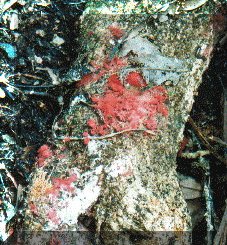|
|
||
|
During a foray in the Gorge Track in Palmerston North I came across some slime moulds for the first time, I did not even know they were slime moulds but did recognize them as fungi. They are not mushrooms and inedible but I found them quite fascinating so I photographed them . I don't know much about slime moulds yet but I did manage to identify these two, so there will be more info to come on these mysterious little things!! |
||
|
Family |
Species |
Photo |
|
Stemonitaceae |
Stemonitis axifera
Found on October 22, 2000 in Manawatu Gorge Track, Palmerston North. About 1.5-2cm high and in groups of large numbers clustered on rotting
wood!!
|
  If you look closely at the picture on the left you may just be able to see the threadlike stems at the base of the fruiting body!! |
|
Trichiaceae
|
Arcyria denudata
Found on the same day as S. axifera (Oct. 10,2000) at the Manawatu Gorge in Palmerston North. This mould looks very similar to S. axifera but lacks the shiny ball on
the surface and did not grow is as big clusters or groups.
|

|
|
Enteridiaceae |
Lycogala epidendrum
This specimen was found at the Manawatu Gorge Track in October 2003. About the size of a pea, but stands out in amongst moss due to it's bright pink colour. Very tidy appearance, almost delicious looking, firmly attached to it's host which is dead wood. Filled with a viscous cream the same colour as the outside. Turns brown at maturity and releases it's spores. The second photo shows the contents when it was popped. |
 |

